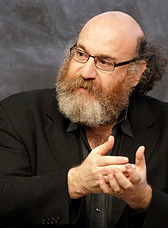William Bialek is a world-renowned theoretical physicist whose work bridges the gap between physical and life sciences. He is the John Archibald Wheeler/Battelle Professor of Physics, and a member of the multidisciplinary Lewis-Sigler Institute for Integrative Genomics at Princeton University. In addition, he is Visiting Presidential Professor of Physics at the Graduate Center, City University of New York.
The focus of Professor Bialek’s work is to understand how physical principles underlie the performance of biological systems. According to Bialek, an understanding of these issues requires an integrated view across multiple levels of biological organization, from individual molecules, to cells and cellular circuits, to central processing within the brain. Much of Bialek’s work is informed by his close collaborations with experimentalists from fields as diverse as psychology, biology, chemistry and physics. He has also extensively collaborated with other theorists, from physics to computer science and mathematics. His ongoing research has addressed a large number of problems across these broad areas.
Professor Bialek’s ideas have left their mark on several distinct areas within the life sciences, including neuroscience, animal behavior, and cell and developmental biology. He has contributed important insights into how individual neurons encode natural sensory stimuli as well as the statistical behavior of large collections of neurons. He has published influential studies in behavioral biology, specifically the application of statistical models to understand eye movements in monkeys, flocking behavior in birds, and movement patterns in C. elegans. In cell and developmental biology, Bialek has made important contributions to the study of intracellular signaling networks and pattern development in the fly embryo.
In addition to his scientific accomplishments, Bialek has been at the forefront of developments in higher education at all levels, especially in training a new generation of scientists in methods of quantitative reasoning relevant for understanding biological systems. He co-directed the Woods Hole Summer Course “Methods in Computational Neuroscience” (1998-2002), and was the primary driver and developer of an innovative curriculum for science majors at Princeton University, the Princeton Integrated Science Curriculum.
Professor Bialek has published over 140 empirical and theoretical papers and review articles. His work has appeared in all the leading science journals, including Science, Nature, and Proceedings of National Academy of Sciences. Among his publications, he is co-author of two books, The Vertebrate Inner Ear (CRC Press, 1985) and Spikes: Exploring the Neural Code (MIT Press, 1997), is editor of Princeton Lectures on Biophysics (World Scientific, 1992), and is author of Biophysics: Searching for Principles (Princeton, 2012).
Bialek was elected Member of the National Academy of Sciences and Fellow of the American Physical Society and received multiple awards, including a Phi Beta Kappa Award for excellence in teaching and the Presidential Young Investigator award by the National Science Foundation.


